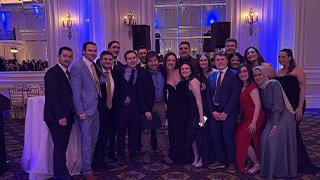Occupational Therapy Student Calls on Therapists to Keep the Elderly Online and Out of Stores
Thursday, March 19, 2020

Occupational Therapy graduate student Etana Edelman
On the second Sunday of March, Etana Edelman's (SHMS OT '20) 86-year-old grandmother told her she was stepping out of her apartment in Florida to pick up some groceries and supplies from her neighborhood shopping center.
Under normal circumstances, this would not have caused any alarm. In March 2020 however, during the COVID-19 pandemic, such a trip could unnecessarily expose her to the dangerous pathogen. As officials advise the public to socially isolate with warnings of the specific dangers to the elderly, it is becoming increasingly difficult for the elderly population to safely and independently perform necessary Activities of Daily Living (ADLs) and Instrumental Activities of Daily Living (IADLs), including socializing, exercising and shopping.
For this 26-year-old grad student, buying necessary supplies such as perishables, groceries and even toilet paper can easily be accomplished with a few taps and swipes on her iPhone. For her grandmother who is not as tech savvy, online shopping does not come as naturally. According to Etana, "My grandmother told me that she was apprehensive about going out to get groceries after family members in New York encouraged her to avoid public spaces, but she felt she didn't have any other option."
Etana then had the idea to set up an online shopping account for her grandmother with her local grocery store. After making the account, she guided her grandmother through downloading the app on her phone and taught her how to search for specific items, add them to her cart and order them to be delivered to her apartment. Although it was difficult at first, her grandmother became excited by the new opportunity. She said, "I have heard about people ordering online but never thought I would be able to do it. Once I got the hang of it, it was easier to use."
Some of the challenges that they faced was the limited online stock of certain items, and that orders would not be delivered for more than five days due to high volume. Etana helped her grandmother anticipate what she would need by that time to make an appropriate order. By the next day, her grandmother had told her friends about the website and they were all interested in learning about it as well.

Online resources are crucial tools in helping the elderly population avoid having
to break isolation to go to shopping centers. One of the main barriers to using these
resources is knowledge of how to use them effectively. This presents an opportunity
for Occupational Therapists (OTs) and other healthcare providers to help their clients
through these difficult times by creating guides to make these available online resources
accessible to this aging population.
Sharing these guides through community center mailings and emails can enable these older adults the access the education that they need. A simple video tutorial itself could be a game changer, and Google, Microsoft or any number of tech companies, especially those that cater to older adults could play an important role in fighting COVID-19. These interventions would help at-risk clients avoid unnecessary exposure to COVID 19 and could potentially save lives.
- Identify grocery stores in the area that deliver "search online grocery delivery (insert zip code)"
- Create account, including email address and password
- Record login information for later use
- Input location information to see if the store will deliver
- Search for specific items
- "milk"
- "eggs"
- "bread"
- "tomatoes"
- Select specific item and quantity
- Click "add to cart"
- Go to checkout by selecting the grocery cart icon in the top right
- Input credit card information
- Input delivery address information
- Click "submit order"
Not Just Food
Health care delivery and everyday life increasingly relies on internet access and
this was trending before COVID-19. Digital health management skills include the ability
to complete online medical forms, order prescriptions, send messages to health care
providers, use telehealth interfaces, personal health trackers, and seek reliable
health resources to improve health or manage chronic conditions. Older adults under
70 with higher education levels and socioeconomic status adopt technology at similar
rates to the general population, with two-thirds of older adults now using the internet.
However, individuals 80 and older are disproportionately not accessing e-technology
(Pew Research Center, 2017) and this population represents some of the most vulnerable individuals to the virus.
In addition, changes associated with the typical aging process, such as decreases in vision, auditory, sensory and cognitive skills, can interfere with the person-website interface. The digital divide remains firmly in place for those in the oldest age categories, as well as for those with lower incomes and less education.
Etana's grandmother is fortunate to have access to digital technologies, some capability to use devices and a granddaughter who is an occupational therapy student who can adapt her instructions to meet her grandmother's needs – resulting in a successful experience.
Telehealth
Medicare announced today that they are paving the way for increased access to telemedicine
to meet physical and mental health needs and to maintain social distancing during
the Covid-19 pandemic (modernhealthcare.com, March 17, 2020). Relaxing regulations to streamline online service delivery assumes that older adults
have skills in digital literacy, including access to digital devices and knowledge
about how to use them, and health literacy, with sufficient understanding of their
health conditions to request assistance and process the health information provided
by health professionals.
It also assumes that they do not have sensory, physical or cognitive changes that would interfere with the use of this technology. The use of SKYPE or electronic portals to health information requires internet skills and a level of self-efficacy to believe that they can be successful operating their devices and navigating in the online environment.
What We Can Do Right Now
Ask, but do not assume that our oldest adults can participate in the online environment.
Start with family and neighbors and look after the most vulnerable during this difficult
time.
- Call people on their preferred communication device first, whether that be a landline or cell phone. Not every older adult will require assistance but may appreciate the opportunity to speak with someone if they live alone to dispel some of the social isolation.
- Determine whether there is a concrete need for assistance with grocery shopping or pharmacy medication orders. If distance is not an issue, then shop for them when you complete your own limited trips to the supermarket, but be careful to not unnecessarily expose them to any illness. Online shopping, as Etana noted, requires advance planning due to temporary stocking shortages, but is preferred.
- If the older adult has a health concern, encourage them to call their physician's office if they are unable to use the Internet. Prior to the call, help them create a list of symptoms to enable medical staff to triage them appropriately.
- Ideally, we would follow Etana's model and guide the person to learn to use the technology to meet daily household and medical needs. This solution assumes that there are underlying skills to build upon.
Categories: Health and Medicine





